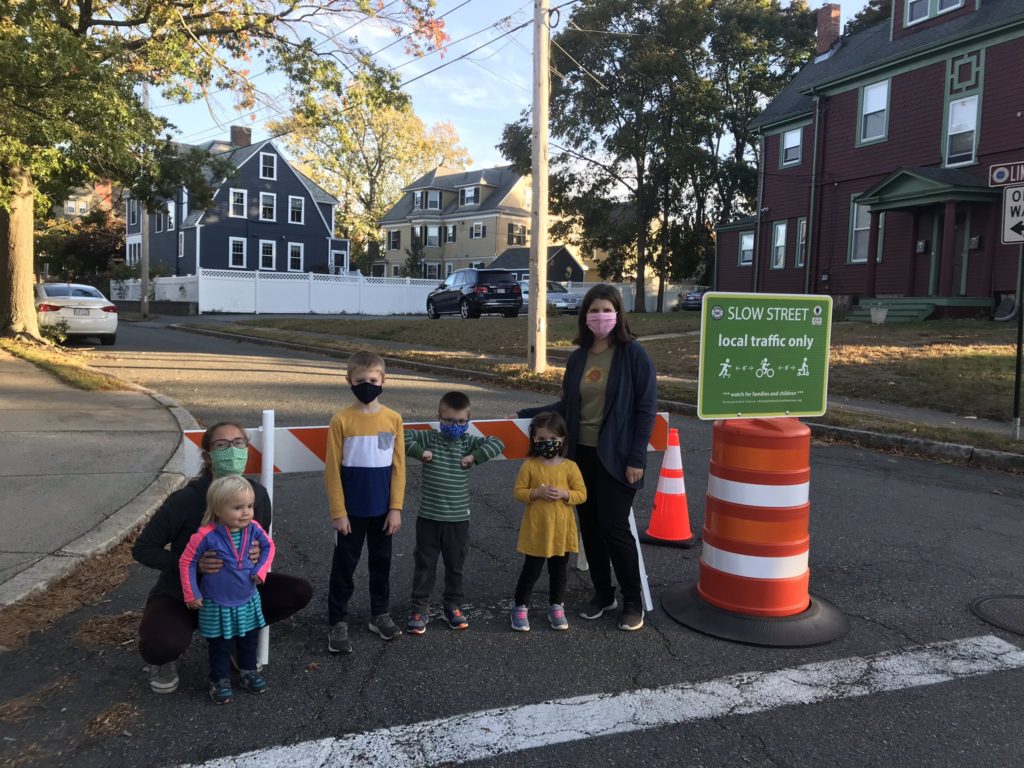What is a “Slow Street?”
In 2020, the city of Melrose received a Shared Streets and Spaces grant through MassDOT. As part of that grant, the city purchased temporary road construction materials like signage, traffic cones, sawhorses, striping tape, and barriers which can be used to create “quick-build” traffic safety projects designed to encourage safer, slower driving, while still allowing for emergency, guest, and delivery access. The Melrose Ped/Bike Committee was proud to be able to provide technical assistance to the city in developing their grant application.
How can I get a “Slow Streets ” project for my street?
In Melrose, every street is a neighborhood! You can apply for a “Slow Streets” program in your neighborhood by emailing sharedstreets@cityofmelrose.org. You should provide your street name, contacts for one or two residents who will volunteer to coordinate the project, and any observations or ideas on what might fit your street best.
Here are some tips on what to expect:
| Stage | Timeline/Description |
|---|---|
| Step 1: Ideas Stage | You know your street best! Think about which specific part of your street would benefit most from slowed traffic and/or more pedestrian space, and who can be a “block captain” to coordinate resident input and serve as liaisons to the city. You will need 70% of occupied homes/residences in the project area to commit to supporting the project. |
| Step 2: Initial Application | Block captains should reach out to sharedstreets@cityofmelrose.org to apply. Please provide your name, address, contact info, relevant City Councilor and provide the city with some background on the goals for your street and whether some neighbors have already expressed interest in supporting the project. The city will assess situations on a case-by-case basis. |
| Step 3: Conduct outreach, gauge initial support, and complete application materials | Block captains will work to conduct outreach to neighbors and gauge initial support. Next, you will need to complete the application materials (e.g. define the project area, develop project design including map, plan, and request for materials). Need some ideas? Check out these example projects on Lynde and Linden. Members of the Ped/Bike Committee have volunteered to work with residents to help design their project. If you are looking for ideas, let us know! |
| Step 4: Collect signatures | Talk with your neighbors! Block captains should attempt to contact all abutters within the project area. The goal is that a minimum of 70% of residences along the project area must commit to the project. This commitment can come in the form of signatures, emails, or other written commitment. The city will provide Block Captains with sample information cards to distribute door to door. The key is to ensure that your neighborhood is welcoming of the project, and enthusiastic about attempts to improve local street safety. |
| Step 5: Schedule Neighborhood Meeting and Preliminary city notice | The city will work with block captains to schedule a neighborhood meeting, then will send a letter to direct abutters of the proposed project area to explain the project in detail and inform them of the upcoming neighborhood meeting. Meetings will likely be scheduled at 7:30am or 5:30pm. |
| Step 6: Final city notice | If the 70% threshold is met and the project is approved, the city (DPW) will send out a final letter informing direct abutters that the project will be moving ahead, and will provide details about the project and an expected start date and end date. |
| Step 7: Install | Melrose DPW will drop off road safety materials with the block captain(s) and/or a designee who is able to set up the installation per the agreed design. |
| Step 7: Project complete | Once the materials are up, the block captain(s) should start collecting feedback and/or keeping an eye on how things are going. You should also expect to check cone placement and reset cones that have been moved, run over, or knocked down by wind. Do cars seem to be traveling more slowly? Do your neighbors feel the street is safer? Are there changes that might be appropriate? Document it all, and send any feedback or thoughts to sharedstreets@cityofmelrose.org. |
Frequently Asked Questions
Q: How long will my project stay up?
A: Projects can start as early as May 15. The specific dates of your project will be detailed in the letter from the city detailing the plans.
Q: Will this close my street to through traffic?
A: No. Your street will remain open to any traffic including residents, non-residents, emergency vehicles, and delivery services. The project design will encourage all users to travel at safe and appropriate speeds while they are traveling through your neighborhood.
Q: Are there any specific procedures that participating streets need to follow for trash/recycling pickup, etc?
A: No. Depending on the layout and the specifics of your road, it may make sense to move the materials the evening prior to trash pickup, and replace them the following afternoon.
Q: We love this project! How can we make it permanent?
A: These projects are intended to be temporary and seasonal, rotating through different streets on an annual basis. For questions about permanent traffic calming, residents are encouraged to contact the Traffic Commission, the Engineering Department, or the Public Works resident services coordinator. Keep up the enthusiasm! Share your love of these projects with your friends, the mayor’s office directly, and your city councilor.

